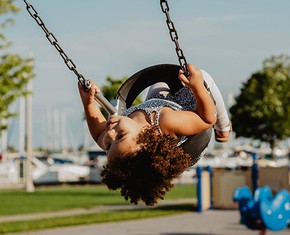The views expressed in our content reflect individual perspectives and do not represent the authoritative views of the Baha'i Faith.
Have you watched the popular short video The Story of Stuff?
It literally explains the story of all the stuff we use: Where does it come from? How was it produced, and at what cost to people and to the environment? Do we really need all that stuff? What happens to it after we throw it away?
Investigating these questions makes us aware of the tremendous impact our consumption has on people around the world—and on the environment. These questions are tangible examples of the issues raised by the Universal House of Justice in March of 2017, in a letter titled Comments on the Path to Economic Well-being. In this letter, the House of Justice—the democratically-elected international governing body of the world’s Baha’is—reminds us to exemplify spiritual qualities such as contentment and moderation:
The forces of materialism promote a quite contrary line of thinking: that happiness comes from constant acquisition, that the more one has the better, that worry for the environment is for another day. These seductive messages fuel an increasingly entrenched sense of personal entitlement, which uses the language of justice and rights to disguise self-interest. Indifference to the hardship experienced by others becomes commonplace while entertainment and distracting amusements are voraciously consumed. The enervating influence of materialism seeps into every culture, and all Baha’is recognize that, unless they strive to remain conscious of its effects, they may to one degree or another unwittingly adopt its ways of seeing the world.
How can we relate these somewhat abstract concepts to our personal lives, and, most importantly, how can we make them accessible to our youth?
The Story of Stuff: A Baha’i-inspired Program for Youth is based on the video The Story of Stuff, and helps youth cope with a culture of consumerism by growing up to be responsible world citizens. Everyone can download the materials for free from The Story of Stuff website.
The six-session course assists young people to see the reality of the world we live in, reveals to them some of the many injustices underlying the current economic system, and encourages them to respond in a spiritual way, to live with ethical principles, and to serve the common good. It illustrates how our world is interconnected and sheds light on the social conditions of the people who produce or manufacture all the goods we consume.
The Baha’i version of the course is based on the original Christian and Jewish editions. While the course lays out the Baha’i perspectives on the issue, it is interfaith in spirit and therefore lends itself especially well to use by a diverse group of youth. Its materials show equal respect for all religions, and teach that all people worship the same God, just with different names—and that the core spiritual teachings, such as stewardship of the Earth and loving and caring for our fellow human beings, are the same in all religions.
The course can be used with existing youth groups, or it may be of help with forming new groups by starting them off with a topic of widespread concern.
The materials are designed for 12–15 year olds, but are easily adaptable to different ages and circumstances. To date, the materials have been tested twice—once in Arizona and once in Rhode Island. Experiences and feedback from both groups were incorporated in the materials.
In Rhode Island, six youth, ages 9–14, explored The Story of Stuff with a wide variety of activities. At the beginning of each session they listened to various renditions of this prayer by Baha’u’llah:
Blessed is the spot,
and the house, and the place,
and the city, and the heart, and the mountain,
and the refuge, and the cave,
and the valley, and the land,
and the sea, and the island,
and the meadow
where mention of God hath been made,
and His praise glorified. – Baha’i Prayers, p. iii.
In the first session, the youth reflected about the beauty of Creation and our role as stewards of the Earth. In the second session, they studied the whole Story of Stuff, from cradle to grave, and its impact on people and the planet. They learned about the Golden Rule as it is expressed in all religions: We should do onto others as we wish they would do onto us. In this session the youth had an especially passionate discussion.
In the third session, the group studied the production of clothing, jewelry, electronics, and cosmetics in small groups and were confronted with the true cost of production: the destruction of ecosystems, the poisoning of workers, and the release of toxins into the environment. The team that studied the origins of T-shirts estimated the true cost of a single T-shirt to be $100!
In the fourth session, the youth learned about how advertisements manipulate us to keep us consuming. They discussed moderation and the fact that lasting happiness does not come from material things. True happiness comes from the spiritual things we cannot touch, such as love, friendship, creativity, learning, generosity, and service. The youth did skits about manipulative ads and reflected on how we can think for ourselves, reduce our consumption, and lead more meaningful and happier lives. One of the youth mentioned that she feels more at peace now. When asked why, she explained that she feels free from the pressure of having to get all that stuff.
In the fifth session, the group learned where stuff goes when it leaves our hands and how the waste harms people and wildlife, especially electronic waste and plastics. The youth conducted a memorable garbage audit, and discussed how we can all reduce the amount of stuff we throw away.
In the sixth and final session, the youth consulted about a service project. They came up with and unanimously decided to work for a plastic-bag ban in their town. Since then, they’ve written a letter to the editor of their local newspaper, conducted a small survey with businesses in other towns that already have plastic bag bans, had a table at a school eco-fair, and showed the video The Story of Stuff in their town library.
We hope that many other young people will enjoy the course!
This article is based on a similar article which appeared in the May 2018 issue of the Wilmette Institute eNewsletter.
















Comments
Sign in or create an account
Continue with Googleor